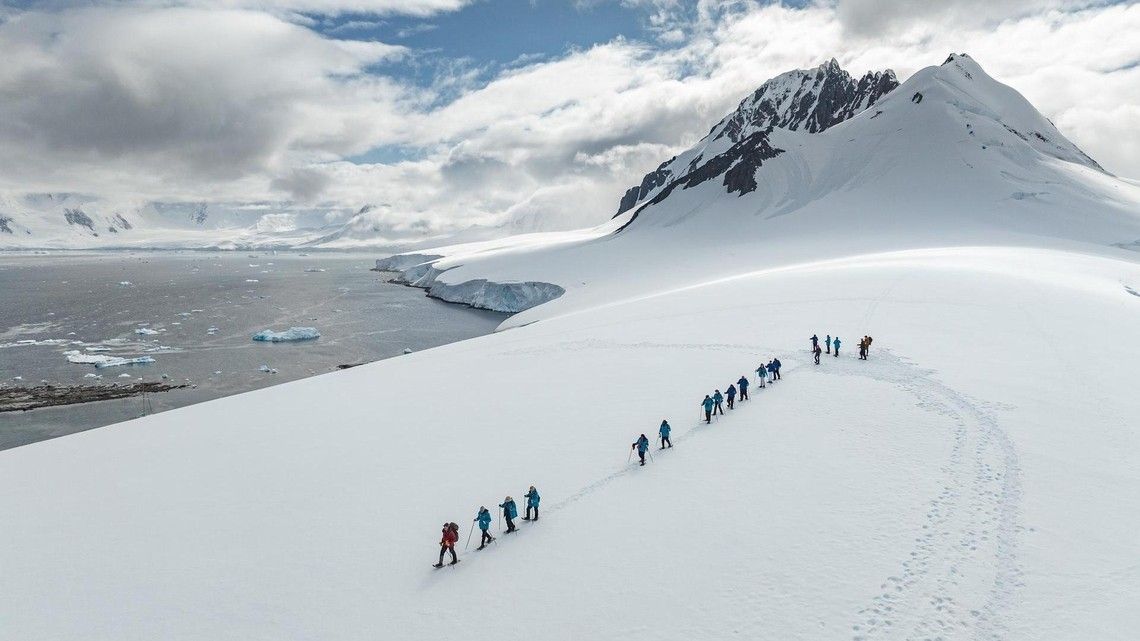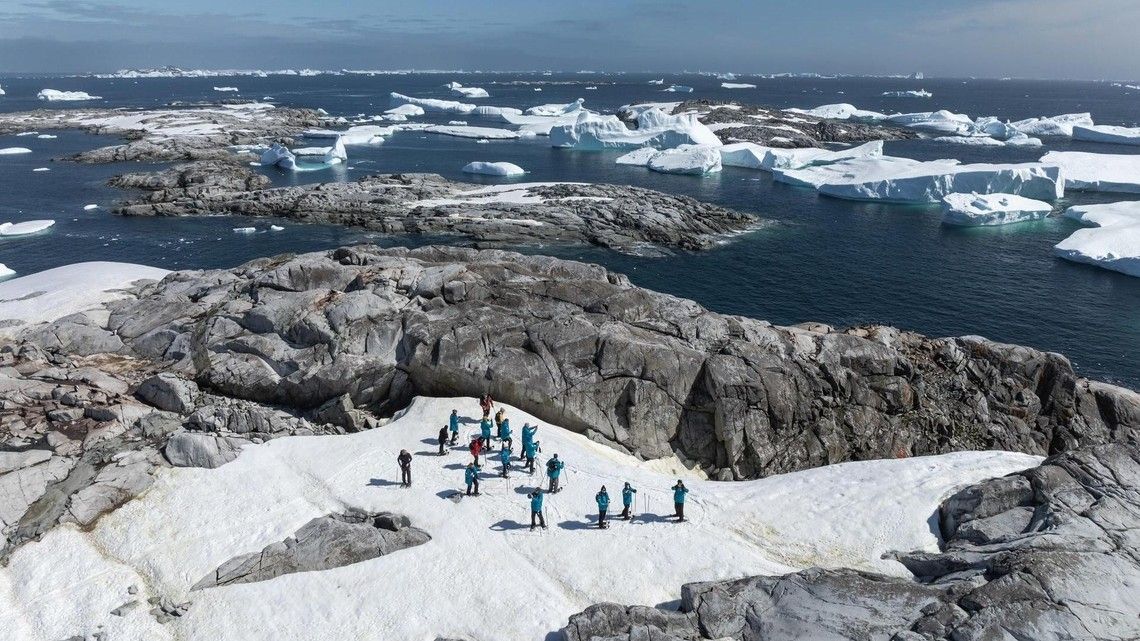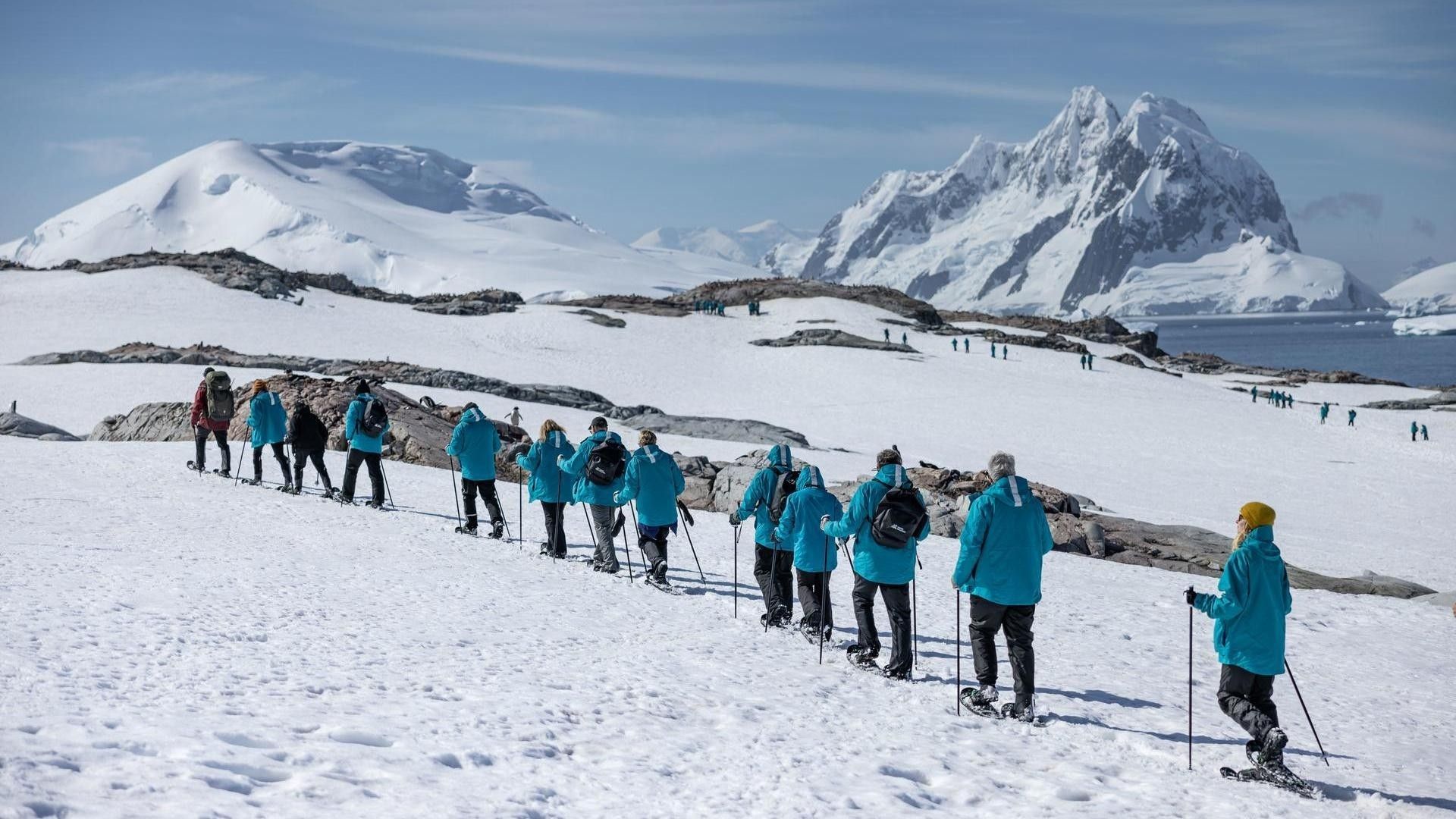Penguins, staying warm and kick-stepping?! Our Corporate Expedition Leader, Antony Jinman gives us the lowdown on our new snowshoeing excursions…
Hi Antony, what makes Antarctica such a special place for snowshoeing?
Antony: It has to be the remoteness and pristine polar environment! The opportunity to walk on the wild-side. For me, it’s Antarctica’s dramatic mountainous landscape climbing out of the rich blue ocean that offers an adventure and view like no other.
What can guests expect from a typical snowshoeing excursion with Swan Hellenic?
Antony: A typical snowshoe adventure lasts for about 1.5 hours. They’re led by two experienced mountaineers and the route will normally offer an opportunity to explore a little further than a normal landing activity, as the snowshoes enable the user to walk in softer snow with ease.
What kind of terrain will guests be walking on, and how challenging is it?
Antony: This very much depends on the location and where we can go due to the ever-changing Antarctic weather. The mountainous peninsular juts out in the Southern Ocean and is notorious for heavy snow. Snowshoeing is open to beginners and experienced alike. We have a number of snowshoeing locations, and depending on the day we’ll be able to offer the snowshoe activity. Some of the routes may offer an easier route exploring Gentoo Penguin rockeries, like at Demoy, whilst others may have a more challenging snowy hill to climb, such as Orne Harbour. Our Mountain Leaders will help describe each location the evening before, helping guests decide on where to go.
What wildlife might guests encounter while snowshoeing in Antarctica?
Antony: Guests will be able to explore penguin colonies (Gentoo and Chinstraps), Seals hulled out on the ice (halfmoon Island) or watch whales in the ocean below.

What essential techniques should first-time snowshoers know before heading out?
Antony: Here are some essential techniques for first-time snowshoers to keep in mind. These tips should help them enjoy the experience and stay safe!
1. Proper stride – When snowshoeing, you want to maintain a wide, slightly exaggerated stride to keep your balance and prevent tripping on the snowshoes. Step with your toes pointing slightly outward to avoid hitting your snowshoe frames.
2. Pace yourself – Snowshoeing can be more strenuous than regular hiking due to the extra resistance from the snow. Start with a moderate pace and take breaks as needed to avoid exhaustion.
3. Use Poles for balance – Trekking poles are very helpful for balance, especially when navigating uneven terrain. They also reduce strain on your legs and help you maintain a steady rhythm.
4. Climbing uphill – When going uphill, use the "kick-step" method. Dig your toes into the snow with each step to gain traction, and keep your body weight forward to prevent slipping.
5. Descending safely – Going downhill requires more caution. Keep your weight back and take short, controlled steps. If the slope is steep, use your poles for extra stability.
6. Stay on marked trails – It’s easy to get disoriented in snow-covered terrain. Stick to well-marked trails or travel with a guide to ensure you stay safe and avoid getting lost.
7. Dress in layers – The weather can change quickly in the snow, so wearing layers that you can add or remove as needed will help you stay comfortable. Don’t forget to wear moisture-wicking clothes to keep sweat from chilling you.
8. Watch for snow conditions – Be mindful of the snow conditions. Soft, deep snow can be tiring to walk through, while icy patches may require extra caution to avoid slipping.
What kind of clothing and gear is best suited for snowshoeing in extreme cold?
Antony: Luckily we provide guests visiting the polar regions with a high-quality, water- and windproof expedition parka to keep. They’re perfect for keeping warm, especially when the wind gets up. Other than that, the layering system mentioned above. Guests also get a free waterproof backpack, which is perfect for carrying cameras and any extra layers you might want to bring along.

How do guides ensure safety while snowshoeing in such a remote environment?
Antony: Good question! Our guides prioritize these four key safety measures to ensure a secure and enjoyable snowshoeing experience in Antarctica…
1. Expert training and knowledge Swan Hellenic guides are highly trained in wilderness safety, first aid, and snowshoeing techniques, ensuring they are equipped to handle any situation. They are experienced in navigating Antarctic terrain and weather conditions, so guests are in capable hands throughout the expedition.
2. Thorough safety briefings and preparation Before heading out, guides provide clear, concise safety briefings, covering essential snowshoeing techniques, group expectations, and what to do in case of an emergency. They ensure all guests are properly equipped, including checking their gear, ensuring the correct clothing, and providing trekking poles if necessary.
3. Constant communication and monitoring Guides maintain continuous communication with the expedition team and are always in contact with the ship, allowing them to monitor weather conditions and the group’s progress. This ensures prompt support if needed, as well as real-time adjustments to the itinerary based on safety concerns.
4. Group management and supervision Guides keep a close watch on guests, ensuring that everyone stays within the designated group and follows safe routes. They manage group sizes, making sure that no one is left behind and that all participants are comfortable with the pace and conditions. They also conduct regular head-counts to ensure no one is lost or out of sight.
What’s the most unforgettable moment you’ve experienced while snowshoeing in Antarctica?
Antony: Portal Point is always a special place for me because it’s a place I know very well. In 2022, I was on an expedition crossing the peninsular of Antarctica on skis. Unfortunately, due to Covid, the cruise ship company that dropped my team off, couldn’t pick us up and we had to be rescued. Swan Hellenic answered our call for assistance, and so every time I come back and put on my snowshoes at Portal Point, it brings back fond memories of my team mates and the joy of being picked up by the Swan Hellenic crew.
How does snowshoeing compare to hiking or other ways of exploring the Antarctic?
Antony: Hiking in deep snow is very hard work! Unlike regular hiking, snowshoeing is specifically designed for deep snow and icy conditions. Snowshoes distribute your weight across a larger surface area, preventing you from sinking into soft snow or getting bogged down in deep drifts. Hiking, in contrast, can be much more difficult and tiring in snowy terrain, as the added resistance can make each step feel heavier.
Besides Antarctica, where else in the world would you recommend for an incredible snowshoeing experience?
 Antony: I’d recommend these places…
Antony: I’d recommend these places…
• Banff National Park, Canada Banff is one of the most famous winter destinations in the world, with vast forests, towering mountains, and frozen lakes. Snowshoeing here allows adventurers to explore pristine wilderness areas, including the popular Lake Louise and Moraine Lake areas. With a mix of easy trails and more challenging routes, there’s something for everyone.
• Yosemite National Park, USA In the winter, Yosemite transforms into a snow-covered wonderland, and snowshoeing is one of the best ways to experience it. The Mariposa Grove of Giant Sequoias, with its massive trees, and the iconic Yosemite Valley, with views of Half Dome and El Capitan, offer memorable experiences for snowshoers.
• The Dolomites, Italy For a more European experience, the Dolomites in northern Italy are a beautiful location for snowshoeing. The dramatic, jagged peaks are stunning in the winter months, and you can explore tranquil forests, alpine meadows, and hidden valleys. The region also offers great opportunities for guided snowshoe tours.
• Lapland, Finland Lapland, located in the far north of Finland, offers a magical snowshoeing experience. Explore the snowy forests, frozen lakes, and peaceful wilderness areas. This region is also famous for the Northern Lights, which can add a mystical element to a snowshoeing adventure. You might even get to experience a reindeer-sled ride or stay in an ice hotel!
